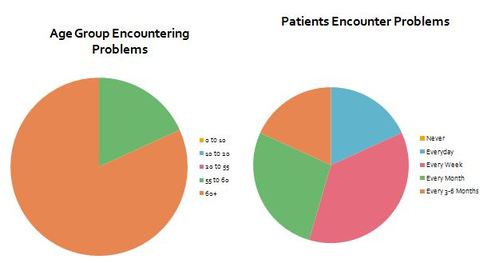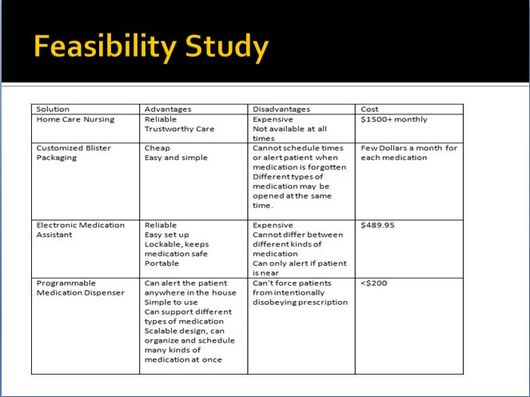Problem
The problem our group decided to approach was the misuse in consumption of modern pharmaceuticals. This problem is most common among patients with low memory retention abilities or those that are easily confused with prescription timing. After consulting many pharmacists in the greater Vancouver area we justified a need for a controlled and mediated medication consumption. The pharmacists reported that over 80% of the cases of medication misuse were with patients 60 years or older. These patients could be reported to have missed medication as often as four times a week. When we inquired as to what price most patients should pay the pharmacists implied that most patients in this target market wouldn’t be able to afford anything more $10 a month or a $75 dollar permanent investment. With the target market being the elderly population who are mostly on a strict budget, our team needed to come up with a simple design that could be mass produced under a low cost manufacturing requirement.
After researching the options available and performing literature survey to find what specific needs of this specific demographic, we generated a simple design with the most versatility. This design was not only applicable to elderly who forget, but also patients who are hearing or visual;y impaired. This design could be further specified with a lockable medication compartment to decrease the likeliness for substance abuse. Our final product was designed to be available to any patient needing a medication dispenser regardless of their condition.
After researching the options available and performing literature survey to find what specific needs of this specific demographic, we generated a simple design with the most versatility. This design was not only applicable to elderly who forget, but also patients who are hearing or visual;y impaired. This design could be further specified with a lockable medication compartment to decrease the likeliness for substance abuse. Our final product was designed to be available to any patient needing a medication dispenser regardless of their condition.
Statistics
- “In fact, statistics show 38 million senior Americans have drug complications every year. 180,000 of those complications could kill.”
- “Data suggest that the use of three or more drugs a day places elderly people at particular risk of poor compliance. Estimates of as many as 25% of older people taking at least three drugs. The most common noncompliant behaviour of the elderly appears to be underuse of the prescribed drug.”
- Control of medication dosage in elderly patients
- Over 100,000 people are estimated to die each year in the United States due to failure to adhere to prescribed treatment.
- One in every five (21%) patients never follow their prescription
- One in every twenty (6%) are not capable of identifying their own medicines
For many seniors, prescription drug abuse can quickly lead to addiction, creating or compounding pre-existing physical and psychological issues.
- 10% of all hospital admissions are the result of prescription medication noncompliance.
- 23% of all nursing home admissions are due to failure to take medications accurately.
- The average length of stay in hospitals due to medication noncompliance is 4.2 days.
- “Data suggest that the use of three or more drugs a day places elderly people at particular risk of poor compliance. Estimates of as many as 25% of older people taking at least three drugs. The most common noncompliant behaviour of the elderly appears to be underuse of the prescribed drug.”
- Control of medication dosage in elderly patients
- Over 100,000 people are estimated to die each year in the United States due to failure to adhere to prescribed treatment.
- One in every five (21%) patients never follow their prescription
- One in every twenty (6%) are not capable of identifying their own medicines
For many seniors, prescription drug abuse can quickly lead to addiction, creating or compounding pre-existing physical and psychological issues.
- 10% of all hospital admissions are the result of prescription medication noncompliance.
- 23% of all nursing home admissions are due to failure to take medications accurately.
- The average length of stay in hospitals due to medication noncompliance is 4.2 days.
Solution
We developed a solution that would dispense three medications, but could be scaled up to as many as needed, and dispense up to twenty of each medication per day based on an input time by the user, their caretaker, or local pharmacist.
The mechanical design is composed of the three hoppers that focused the pills into a choke point at the bottom. Each medication has its own servo motor with a thin cylinder mounted on a rod attached. Below the cylinder is a metal place that prevents multiple doses from being delivered. The cylinder has specified hole cut into it that allows one dose of the medication to be accepted from the hopper. The servo spins the cylinder and rotates the medication dose from position one to position two which are 180 degrees apart. At position two the medication dose slip through a hole cut in the lower metal plate and the medication does in released into a tub that guides it to a holder positioned on the lower side of the device for the patient. Attached to this holder is a Laser sensor that detects and notifies the patient of medication waiting to be taken.
Please refer to the PDF available on our homepage for details on how our product is cheaper and more beneficial than alternatives available in the market today, as well as our decision making process for the final design of our project.
The mechanical design is composed of the three hoppers that focused the pills into a choke point at the bottom. Each medication has its own servo motor with a thin cylinder mounted on a rod attached. Below the cylinder is a metal place that prevents multiple doses from being delivered. The cylinder has specified hole cut into it that allows one dose of the medication to be accepted from the hopper. The servo spins the cylinder and rotates the medication dose from position one to position two which are 180 degrees apart. At position two the medication dose slip through a hole cut in the lower metal plate and the medication does in released into a tub that guides it to a holder positioned on the lower side of the device for the patient. Attached to this holder is a Laser sensor that detects and notifies the patient of medication waiting to be taken.
Please refer to the PDF available on our homepage for details on how our product is cheaper and more beneficial than alternatives available in the market today, as well as our decision making process for the final design of our project.
The video above shows the Medication C pill being dispensed at the pre-set time of 00:04. The pill rolls into the container where it is detected by the sensor circuit triggering the alarm.


